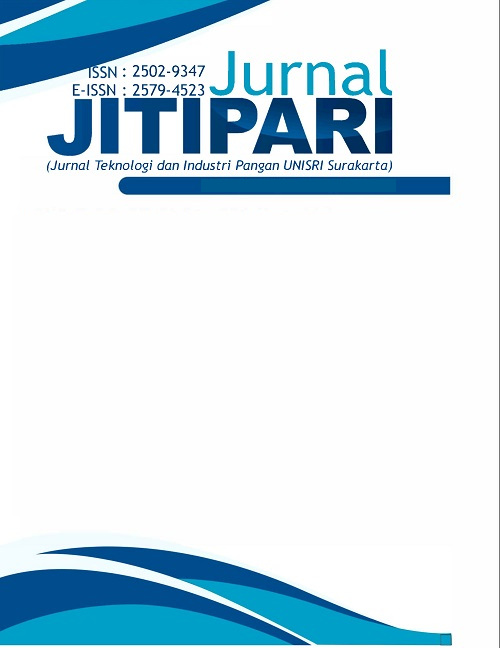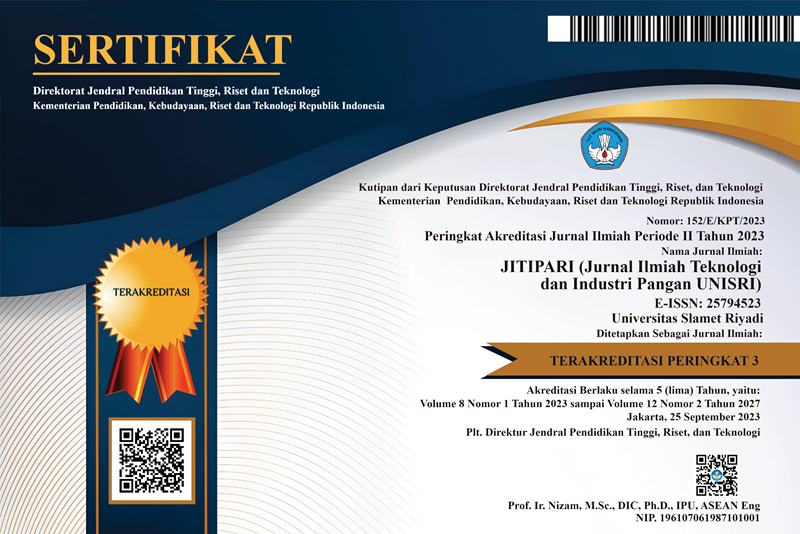Antioxidant Activity of Colored Rice Flour with Drying Temperature Variations
DOI:
https://doi.org/10.33061/jitipari.v8i2.7250Abstract
Rice is the main product obtained from grain produced by the rice plant (Oryza sativa) whose entire layer has been peeled off and the bran layer has been separated in the form of head rice, whole rice grains, broken rice, and groats. There are several types of pigmented rice such as brown rice, black rice and black glutinous rice. These kinds of rice have not been utilized optimally so that a processing process is needed to increase the economic value of the colored rice. One of the processing is made as flour so that it is durable and easy to distribute and flour can be used as a food processing material that is practical, easy and durable. One of the processed rice is rice flour. Colored rice flour is the result of processing brown rice, black rice and black glutinous rice by milling or flouring. This study aims to determine the optimal temperature in the manufacture of colored rice flour in order to obtain colored rice flour which has high antioxidant activity and high anthocyanins. The result of flouring is in the form of very fine grains. Flour has a low water content so it is more durable and long lasting. In order to reduce the moisture content, drying is carried out. The study used a completely randomized design (RAL) consisting of 2 factors. The first factor was the type of colored rice, while the second factor was the drying temperature of rice flour. The optimal treatment results were a combination of black glutinous rice flour treatment and a drying temperature of 45°C for 60 minutes, the following results were obtained: water content 7.44%, antioxidant activity by DPPH method 69.89%, antioxidant activity by FRAP method 81.35%, yield 25.29%, total phenol 175.85 mg/kg, and anthocyanin levels 327.10 ppm. Changes in temperature during the drying process of colored rice will affect the characteristics of the colored rice.
References
Anggraini, T., Dewi, Y. K., & Sayuti, K. (2017). Karakterestik sponge cake berbahan dasar tepung beras merah, hitam, dan putih dari beberapa daerah di sumatera barata. Jurnal Litbang Industri, 7(2), 123.
AOAC. (2012). Official methods of analysis association of official of analysis chemist. Whasington.D.C: AOAC International
Badan Standarisasi Nasional. (2009). Tepung beras sebagai bahan makanan. SNI 3549:2009, 1–44.
Badan Standarisasi Nasional. (2015). Beras: SNI 6128:2015. BSN
Clarke, G., Ting, K. N., Wiart, C., & Fry, J. (2013). High correlation of 2,2-diphenyl-1-picrylhydrazyl (DPPH) radical scavenging, ferric reducing activity potential and total phenolics content indicates redundancy in use of all three assays to screen for antioxidant activity of extracts of plants from the m. Antioxidants, 2(1), 1–10. https://doi.org/10.3390/antiox2010001
Giusti, M., & Wrolstad, R. E. (2001). Characterization and measurement of anthocyanins by UV-visible spectroscopy. Handbook of Food Analytical Chemistry, 2-2, 19–31. https://doi.org/10.1002/0471709085.ch18
Hernawan, E., & Meylani, V. (2016). Analisis karakteristik fisikokimia beras putih, beras merah, dan beras hitam (Oryza sativa L., Oryza nivara dan Oryza sativa L. indica). Jurnal Kesehatan Bakti Tunas Husada, 15(1), 79.
Hidayat, R. R., Sugitha, I. M., & Wiadnyani, A. A. I. S. (2019). Pengaruh perbandingan tepung beras hitam (Oryza sativa l.indica) dengan terigu terhadap karakteristik bakpao. Jurnal Ilmu Dan Teknologi Pangan, 8(2), 207. https://doi.org/10.24843/itepa.2019.v08.i02.p11
Indriyani, F., Nurhidayah, & Suyanto, A. (2013). Karakteristik fisik, kimia dan sifat organoleptik tepung beras merah berdasarkan variasi lama pengeringan. Jurnal Pangan Dan Gizi, 4(8), 116231.
Masduqi, A. F., Izzati, M., Prihastanti, E., Studi, P., Biologi, M., Sains, F., & Anatomi, B. (2014). Efek metode pengeringan terhadap kandungan bahan kimia dalam rumput laut Sargasumpolycystum. Anatomi Fisiologi, XXII(1), 1–9.
https://doi.org/10.14710/baf.v22i1.7804
Muktisari, R. D., & Hartati, F. K. (2018). Analisis aktivitas antioksidan pada beras hitam dan tepung beras hitam (oryza sativa L. indica). Foodscitech, 1(1), 20–27. https://doi.org/10.25139/fst.v11.1002
Orak, H. H. (2006). Total antioxidant activities, phenolics, anthocyanins, polyphenoloxidase activities of selected red grape cultivars and their correlations. Scientia Horticulturae, 111(3), 235–241. https://doi.org/10.1016/j.scienta.2006.10.019
Priska, M., Peni, N., Carvallo, L., & Ngapa, Y. D. (2018). Antosianin dan pemanfaatannya. Cakra Kimia Indonesia, 6(2), 79–97.
Pusvita, D. (2020). Karakteristik fisikokimia tepung beras merah (oryza nivara) dengan perlakuan suhu dan lama pengeringan. (Skripsi). Palembang: Fakultas Pertanian. Universitas Sriwijaya
Reblova, S. (2012). Effect of temperature on the antioxidant activity of phenolic acids. Czech J. Food Sci, 30(2), 171-177. https://doi.org/10.17221/57/2011-CJFS
Sari, D. K., Wardhani, D. H., & Prasetyaningrum, A. (2012). Pengujian kandungan total fenol kappahycus alvarezzi dengan metode ekstraksi ultrasonik dengan variasi suhu dan waktu. Prosiding SNST Ke-3 Tahun 2012, 40–45.
Setiawati, H., Marsono, Y., & Sutedja, A. M. (2017). Kadar antosianin dan aktivitas antioksidan flake beras merah dan beras ketan hitam dengan variasi suhu perebusan. Jurnal Teknologi Pangan Dan Gizi, 12(1), 29–38.
Sudarmadji, S., B. Haryono, & Suhardi (1997). Prosedur analisa untuk bahan makanan dan pertanian. Yogyakarta : Liberty.
Suhartatik, N., Nur Cahyanto, M., Raharjo, S., & S. Rahayu, E. (2013). Aktivitas antioksidan antosianin beras ketan hitam selama fermentasi. Jurnal Teknologi Dan Industri Pangan, 24(1), 115–119.
Syafutri, M. I., Syaiful, F., Lidiasari, E., & Pusvita, D. (2020). Pengaruh lama dan suhu pengeringan terhadap karakteristik fisikokimia tepung beras merah (Oryza nivara). AGROSAINSTEK: Jurnal Ilmu Dan Teknologi Pertanian, 4(2), 103–111. https://doi.org/10.33019/agrosainstek.v4i2.120
Utami Dewi, N., Wrasiati, L., & Anom Yuarini, D. (2016). Pengaruh suhu dan lama penyangrayan dengan oven drier terhadap karakteristik teh beras merah jatiluwuh. Jurnal Rekayasa Dan Manajemen Agroindustri, 4(2), 1–12.
Widanti, Y. A., & Mustofa, A. (2015). Karakteristik organolaptik brownis dengan campuran tepung mocaf dan tepung ketan hitam dengan variasi lama pemanggangan. Joglo, XXVII(2), 272–280.
Yodmanee, S., Karrila, T. T., & Pakdeechanuan, P. (2011). Phisical, chemical and antioxidant properties of pigmented rice grown in Southern Thailand. International Food Research Journal 18(3): 901-906.
Downloads
Published
How to Cite
Issue
Section
License
Copyright (c) 2023 Budiman Nur Arifin, Akhmad Mustofa, Yannie Asrie Widanti

This work is licensed under a Creative Commons Attribution-ShareAlike 4.0 International License.
Authors who publish this journal agree to the following terms:
- Authors retain copyright and grant the journal right of first publication with the work simultaneously licensed under a Creative Commons Attribution-ShareAlike 4.0 International (CC BY-SA 4.0) that allows others to share the work with an acknowledgement of the work's authorship and initial publication in this journal.
- Authors can separately make additional contractual arrangements for non-exclusive distribution published by the journal (e.g., publish it in a book), with an acknowledgement of its initial publication in this journal.
- Authors are allowed and encouraged to send their work via online (e.g., in the institutional repositories or their website) after published by the journal.










